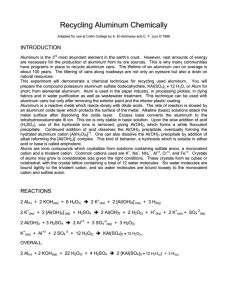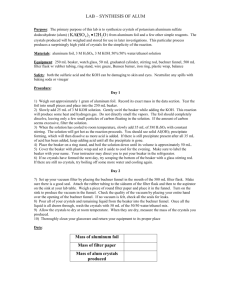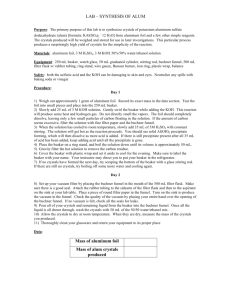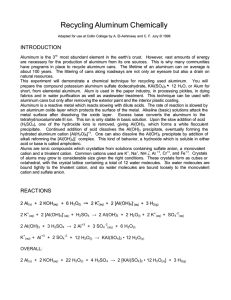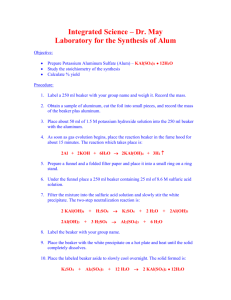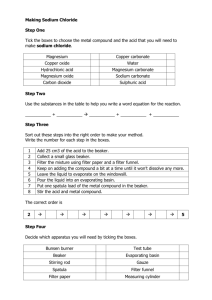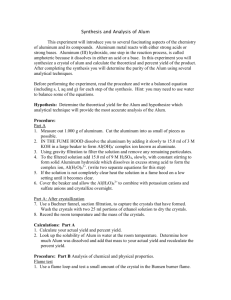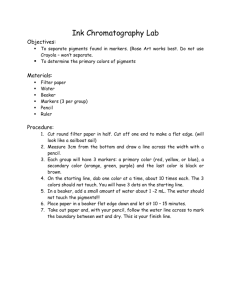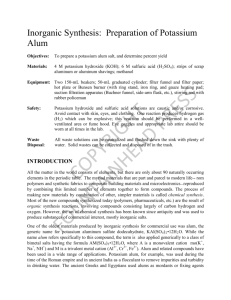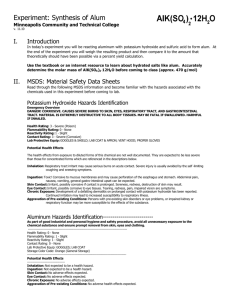University-level STEM Experiment: Recycling Cans to Alum The
advertisement
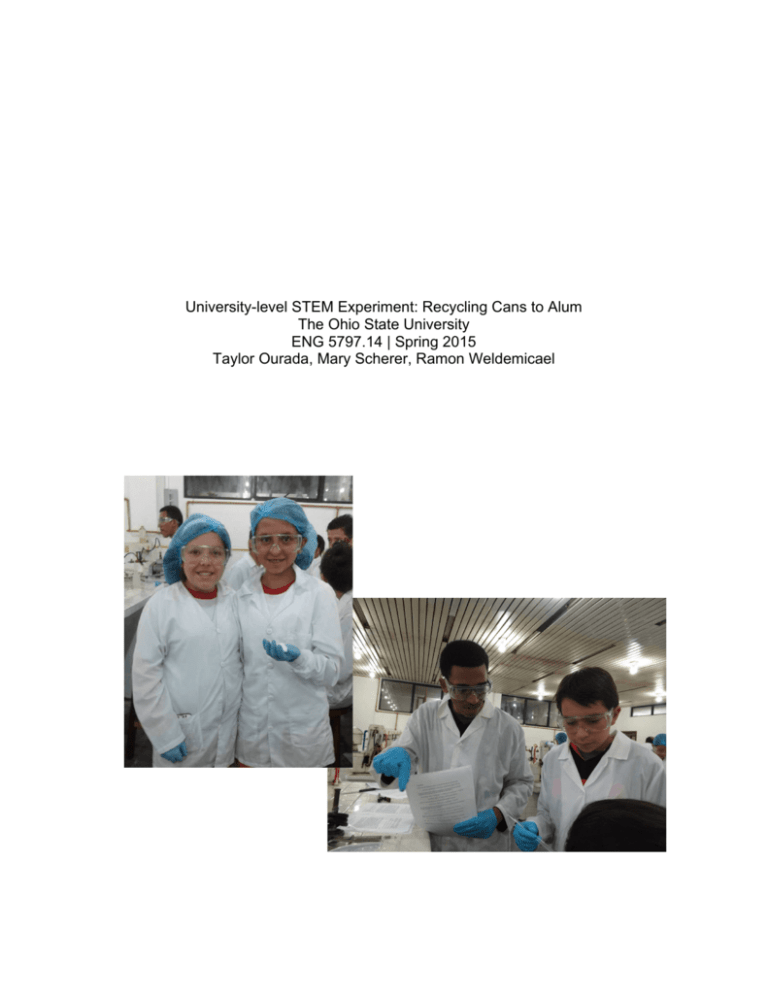
University-level STEM Experiment: Recycling Cans to Alum The Ohio State University ENG 5797.14 | Spring 2015 Taylor Ourada, Mary Scherer, Ramon Weldemicael Table of Contents I. Introduction ...................................................................................................... 1 II. Learning Objectives ........................................................................................ 1 III. Materials .......................................................................................................... 2 IV. Procedure ....................................................................................................... 2 Introduction ................................................................................................................. 3 Pre-lab .......................................................................................................................... 3 Detailed Procedure ..................................................................................................... 4 Continued Exploration.............................................................................................. 11 V. Conclusion .................................................................................................... 12 I. Introduction This experiment is designed for University-level students with an introductory background in general chemistry. The experiment was performed with University students in Pasto, Colombia, at the Universidad de Nariño. The experiment aims to give students hands on experience with inorganic synthesis and focus on the importance of water purification. II. Learning Objectives The following were established as the main learning objectives for the Recycling Cans to Alum experiment. • Students will develop an understanding of chemical recycling as the experiment focuses on creating a new chemical product out of a previously used material. • Students will investigate the water purification process and how coagulants are an integral part. • Students will develop knowledge in inorganic synthesis. • Students will learn laboratory safety principles when working with harsh chemicals and heat sources. 1 III. Materials A main goal of this experiment was affordability. All materials chosen were considered to be easily accessible and free or low cost. Materials required: Sulfuric Acid (H2SO4) Potassium Hydroxide (NaOH) 95% Ethanol Hot plate/heat source Buchner funnel Glassware (500mL & 250mL beakers, stirring rod) Filter paper Personal safety equipment (goggles, gloves, etc.) Sand paper Scissors This experiment should be performed in a laboratory with safety equipment (e.g., lab coats and glasses) as well as fume hoods due to some of the reactions that will be taking place. IV. Procedure This procedure was taken and adapted from the Georgia Institute of Technology Chem 1312 Lab Manual (2008-2009). The introduction, pre-lab questions, and detailed lab procedure can be seen below. A translated Spanish version of the entire lab can be found as Appendix A. 2 Introduction Coagulant chemicals are mainly used in water purification by removing turbidity, color, and some bacteria from water. The primary coagulants neutralize the electrical charges of particles in the water, which causes the particles to clump together. The most commonly used coagulants are alum and ferric sulfate. The process of manufacturing aluminum from its ores requires large amounts of electrical energy. Therefore we must find ways to recycle materials we use. In this experiment, a chemical process will be used that transforms scrap aluminum from soda cans into a useful chemical compounds. Alum or potassium sulfate dodecahydrate will be prepared from the waste aluminum. Alum is a cation and most alums crystallize readily as octahedral or cubes which, under the appropriate conditions, may grow to considerable size. After the alum is produced, it can used in coagulation process. Coagulation is affected by changes in the water's pH, alkalinity, temperature, time, and velocity. Coagulant aids, such as lime and bentonite, are not always required but are generally used to reduce flocculation time. Pre-lab As this experiment aimed to engage University-level students, it was crucial to include an education pre-lab activity to introduce the experiment and key concepts. 1. Define an amphoteric compound and give an example. 3 An amphoteric compound is a molecule or ion that can react as an acid as well as a base. Examples are amino acids and proteins. 2. Describe how to clean up small amounts of very strong acid 9 M? Neutralize with sodium bicarbonate and clean up with a paper towel. 3. Describe how to clean up small amounts of 1.4 M KOH? Clean up using an absorbent, wash area with water and detergent. 4. If the plastic coating from the soda can sample is not completely removed will the yield be higher or lower than just using a pure Al sample? Explain. The yield will be lower than using pure Al because the plastic coating is included in the scrap aluminum measurement. These pre-lab questions can be assigned before the class period or can be done interactively as a class at the beginning of the lab. Detailed Procedure After students have been introduced to the principles of coagulation and introductory chemical principles that will be explored, the hands-on experiment can be performed. Detailed instructions (with pictures of key steps) for the students to follow can be seen below. 1. Carefully cut your aluminum can to a square that is approximately 5 cm x 7.5 cm. 2. Scrape all of the paint off of the can using sandpaper. 3 Figure 1 3. Weigh the square of aluminum and ensure that it is between 0.9 and 1.2 grams of aluminum. Cut off additional pieces of aluminum if needed to obtain a square of this weight. 4. Cut your aluminum square into smaller squares that are 0.5-1 cm x 0.5-1 cm. Place your smaller squares into a 250 mL beaker. 4 Figure 2 5. Measure 50 mL of 1.4 M KOH and pour into the 250 mL beaker containing the small aluminum squares. 6. Place the 250 mL beaker on a hot plate in a fume hood and set to low heat. Leave on low heat for 30 minutes. a. If the liquid level drops to less than half of its original volume, you must add distilled water to ensure that the volume is maintained above 25 mL. The final volume of the liquid should be between 2550 mL. (In some cases, the liquid level remained as high as 75mL – this is okay, too.) b. The reaction is complete when hydrogen is no longer bubbling from the surface. What color changes do you observe during the 30 minutes? What other observations can you note about the aluminum fragments during the reaction? 5 Figure 3 Figure 4 Figure 5 7. Set up a 500 mL filter flask with a Buchner funnel, filter paper, and tube to aspirator on the water facet as seen in the diagram below. It is crucial to make sure that your flask is secured with the clamp and the filter paper is moistened before you begin filtering. 8. Filter the 25-50mL solution using the suction filtration technique. Rinse the beaker with approximately 5 mL of distilled water and pour through the filter. Repeat this rinse a second time. a. The filtrate should be clear with all dark residue remaining on the filter paper. 6 Figure 6 Figure 7 9. Transfer the filtrate to a clean 250 mL beaker. Rinse the filter flask with 10 mL of distilled water and pour into the 250 mL beaker. 10. Prepare an ice bath in a 500 mL beaker by filling the beaker halfway with ice. Add just enough cold water to cover the ice. Cool the 250 mL beaker containing the filtrate. 11. Measure 20 mL of 9.0 M H2SO4. While one group member stirs the filtrate solution, have another member slowly add the 20 mL of 9.0 M H2SO4 to the solution. a. A white precipitate should be observed. You will most likely not sense this, but heat is also generated in this step as well. b. As you continue to add sulfuric acid, the white precipitate will begin to dissolve the Al(OH)3 that was forming the white precipitate. 7 Figure 8 12. Warm the solution at low temp and continue to stir until the Al(OH)3 is completely dissolved in the solution. a. This solution now contains potassium ions (from the KOH), aluminum ions, and sulfate ions. 13. Prepare another ice bath (the same beaker can be used). Set the 250 mL beaker containing the solution from Part 12 in the ice bath to chill for 15 minutes. a. Crystals of alum should begin to form. If crystals do not form within the 15 minutes, you will have to induce crystallization. i. You may add a small amount of ethanol, which will reduce the solubility of the product. ii. You may also scratch the inside of the beaker containing the solution. 8 b. Up to 25-30 minutes total may be required to form the crystallization desired. Figure 9 Figure 10 14. Clean and reassemble the vacuum filtration equipment in order to filter your alum crystals. As a reminder, be sure that your flask is secured with a clamp and your filter paper is moistened before you begin. 15. Filter your solution containing the alum crystals; utilize your rubber spatula to transfer as many of the crystals as possible. 9 Figure 11 Figure12 16. Measure 25 mL of 95% ethanol and chill in an ice bath for 5 minutes. 17. Use a quarter of the ethanol to rinse the alum crystalline product into the filter. Rinse the beaker a second, third, and fourth time using the ethanol to transfer as much product as possible to the filter. 18. Use your spatula to distribute the crystals evenly on the filter paper. 19. Allow the aspirator to pull air through the crystals for 10 minutes. 20. Weigh and record the mass of a weigh boat. 10 Figure 13 21. Transfer the air-dried crystals from the filter paper to a weigh boat using your spatula. Weigh and record the total mass of alum synthesized (subtracting out the initial weight of the boat). 22. Clean up (: 23. Calculate your percent yield: 𝑃𝑒𝑟𝑐𝑒𝑛𝑡 𝑌𝑖𝑒𝑙𝑑 = 𝐴𝑐𝑡𝑢𝑎𝑙 𝑀𝑎𝑠𝑠 ∗ 100 𝑃𝑟𝑒𝑑𝑖𝑐𝑡𝑒𝑑 𝑀𝑎𝑠𝑠 Continued Exploration After the Alum has been created, there are many options for continuing the educational opportunities of this lab. In Pasto, Colombia, the Alum created during the University-level experiment was then used in a demonstration for grade school students who were also learning about water purification. 11 V. Conclusion This experiment engages University-level students in an applicable and relevant chemistry lab that can lead to long-term projects and engagement in the University’s community. This experiment is also highly adaptable and can be simplified or made more complex as the student’s age range changes. Engaging students in sustainable and impactful labs such as this offer an opportunity for educational development as well growing excitement in crucial processes such as the water treatment process. 12

